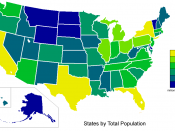INTRODUCTION: Are more males more colorblind than females? In today?s world if you went up to a group of women and asked if they were colorblind many of them would tell you no, but there might be one or two of them that are red-green colorblind. But if you did the same thing but instead went up to a group of guys most of them would tell you that they are red-green colorblind one or two of them would say they are completely colorblind. For men there to be more men colorblind than women is not unlikely in fact a statistics show that about 7 percent of men are colorblind and less than 1 percent of women HYPOTHESIS: If I do a colorblind test on both males and females and test to see whether or not they are red-green colorblind, can see normal color, or if they are completely colorblind.
Then I predict that more males than females are red-green and completely colorblind.
METHOD: Subjects: In this experiment, 50 teenagers and adults were surveyed. For these 50 people they were selected at random. They were divided into two groups? females and males. The ages ranged from 13 to about 40 and the ages were evenly divided between the male and female categories. Some of the subjects were found at school in the halls, or in homerooms, and some were found outside of school at sporting events. There was some times when the subjects were in a group and there was some time when they were alone, for example when they were in the hallways they were typically in a group there was a few of them in the hallway that were not in a group, also when they were in homeroom or a sporting event they were most of the time alone instead of in a group.
This experiment was done as a naturalistic observation (or a field study). It was not a controlled experiment. From that you can see that there was no experimental or controlled group. There is however an independent and dependent variable. The independent variable would be the people who are completely and red-green colorblind. The dependent variable would be the people who can see normal or also called the people who are not colorblind.
Apparatus: This experiment was pretty easy. All the equipment you need for this experiment is a pencil, a data sheet or chart, and a colorblind test (the colored circle with the number imbedded in the colors). For the experiment you will need to us a class room, the hall way and the surrounding recreational events. For the experiment you want to select random people, that way you can get a variety of ages and you also want to make sure you get an equal number of men and women.
Procedure: First for this experiment you have to get the colorblind test, to get that just go on the internet and type in the search books images of a color blind test. Next, pick the one you want and print it of, when you print the picture you want to make sure you know what number they will see if they were red-green colorblind and the number they would see if they saw color normally. Then you make a data sheet or table so that you can keep track of your data. Next you take your picture and go out and survey your subjects, you want to make sure that you get the same amount of males and females; you also want to get a variety of age groups when you do this experiment.
Results: From this experiment and its results it can be conclude that there are more men than women color blind. But however you can not conclude that there are more teenagers than adults colorblind because of the way the survey was done. But if the survey was split into categories you could look at the results and say something like more adult males are colorblind than teenage males. So from this experiment the question: are more men than women are colorblind is answer form the survey. The answer is yes and it can be for a couple of reason hereditary or from a serious illness.





